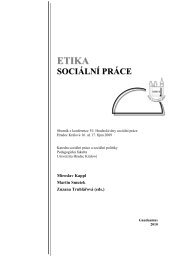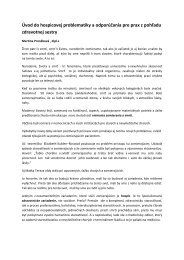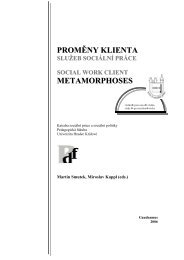Zmena klÃmy â možný dopad (nielen) na obyvateľstvo - Prohuman
Zmena klÃmy â možný dopad (nielen) na obyvateľstvo - Prohuman
Zmena klÃmy â možný dopad (nielen) na obyvateľstvo - Prohuman
Create successful ePaper yourself
Turn your PDF publications into a flip-book with our unique Google optimized e-Paper software.
methods have become indispensable. But as far as climatic changes are concerned,<br />
they still serve as auxiliary techniques. Furthermore, their constant development<br />
and improvement of accuracy and precision, the varying object to measure, evoke<br />
worry that they, to a greater extent, will be affected by the problem of homogeneity.<br />
It also must be realized that even though the atmospheric processes are relatively<br />
well-understood and the existing measurement and research techniques,<br />
including supercomputers and modelling procedures, are highly developed,<br />
weather forecasting for time period longer than a couple of days is still problematic.<br />
Predicting climate changes in the nearest 10 or 100 years, not to mention<br />
greater time span, is then incomparably more complicated. What we have now<br />
are only doubtful sce<strong>na</strong>rios, with still little-understood basics and all kinds of<br />
feedbacks. What if we make just a tiny mistake in our studies? Then the outcome<br />
will be completely altered. Therefore every authoritative and firm statements of<br />
individual researchers must be questioned, especially if they are uncritically expressed<br />
by politicians and decision-makers.<br />
Climate change sce<strong>na</strong>rio – projection or fiction?<br />
Modern approach to the climate change forecasting relies on General Circulation<br />
Models (GCMs) which simulate the climate system. They are based on basic<br />
physical laws and use hydrody<strong>na</strong>mic and thermody<strong>na</strong>mic equations. The numerical<br />
global circulation models are complex and expensive; as a result, only a few<br />
research centres around the world are able develop them. The horizontal spatial<br />
resolution of the contemporary models reaches 100 km, which is a huge step forward<br />
if compared to first attempts in modelling that were made twenty years ago.<br />
Equally important is the growing number of applied variables.<br />
In addition to numerical models, the climate change sce<strong>na</strong>rios employ also<br />
predictions of greenhouse gasses emission as well as other pollutants connected<br />
with both socio-economic development of the world and the ecology actions. In<br />
the Special Report on Emission Sce<strong>na</strong>rios (SRES 2001) an exceptio<strong>na</strong>l interest is<br />
given to sustai<strong>na</strong>ble development, which allows to design sce<strong>na</strong>rios in which the<br />
greenhouse gasses emission will have become stable by 2050 (sce<strong>na</strong>rio B1 and B2).<br />
Depending on what model and which sce<strong>na</strong>rio is taken into account, the future<br />
climatic changes may be calculated, but they generally do not reach beyond the<br />
year 2100. The outcome of such projections are often referred to and discussed<br />
in the literature of climatology. For example, it is worth familiarizing oneself with<br />
the Fourth (IPCC 2007) and, currently in development, Fifth Assessment Report of<br />
the IPCC. The raise of average global temperature presented in them is relatively<br />
pessimistic: even if the assumed temperature raise for the 2020–2029 decade will<br />
106

















